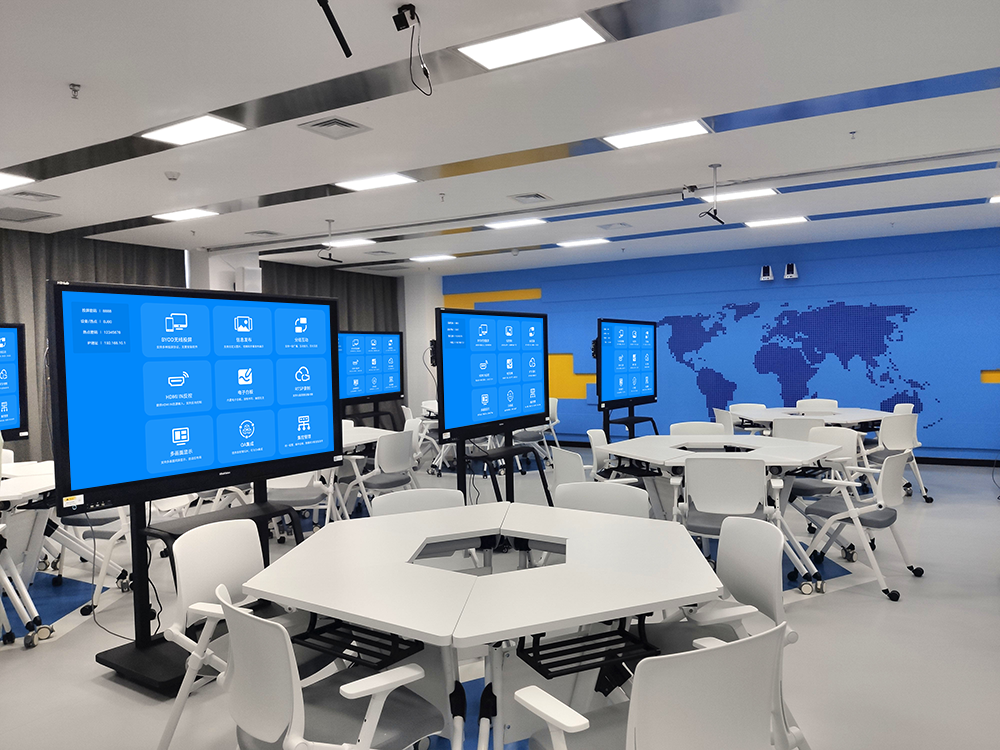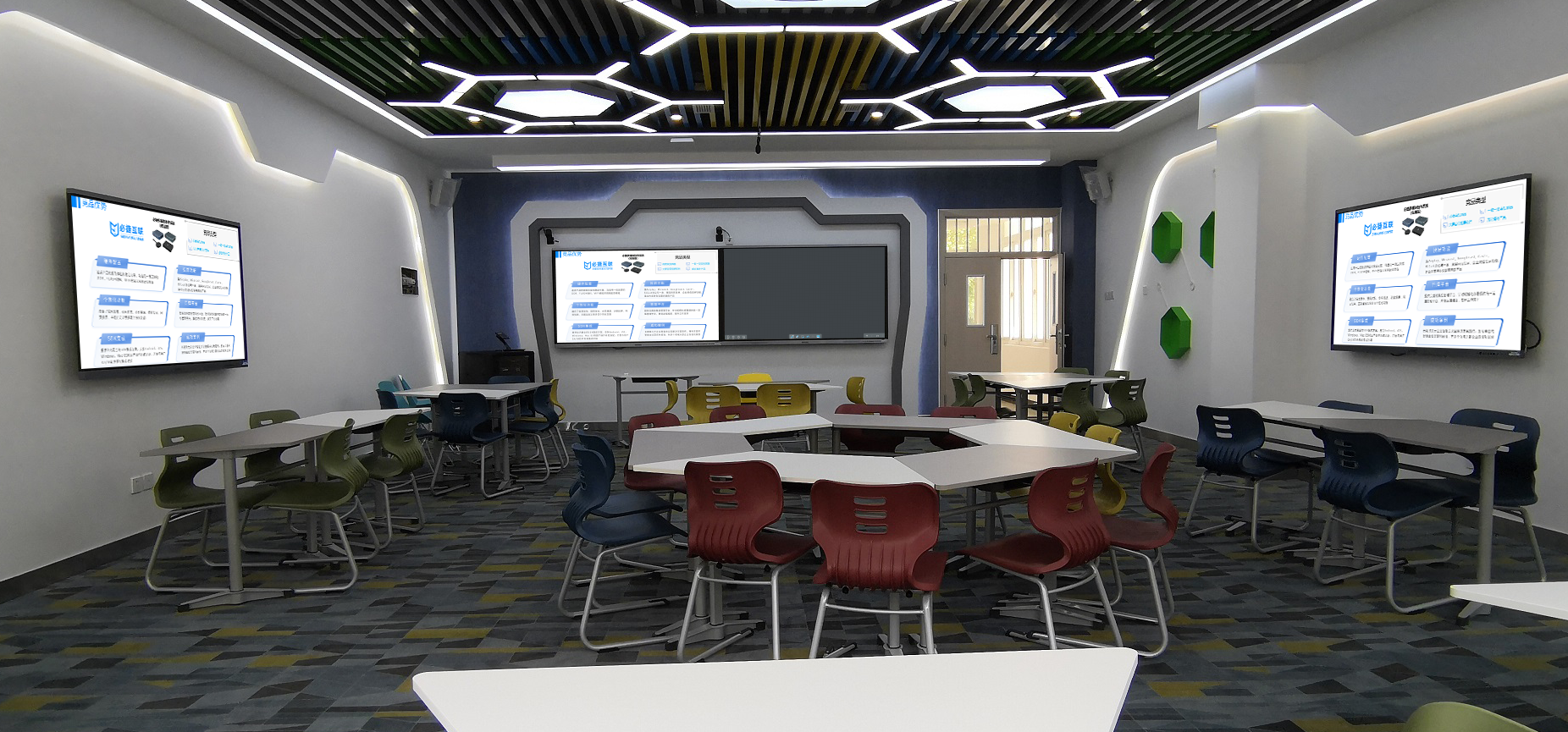Interactive Classrooms: More Dynamic In-Class Communication
Want to help interactive classrooms eliminate “isolated devices and inefficient interaction”? This screen mirroring device makes it easy! Compatible with teachers’ computers/tablets and students’ phones/iPads, it supports instant courseware transfer, real-time annotation, and quick result sharing. Covering scenarios such as daily teaching, group collaboration, and in-class assessments, it transforms classrooms from “one-way knowledge delivery” to “two-way co-creation”—with zero learning threshold for both teachers and students.
1-Minute Interactive Activation: Stress-Free Operation
A process even new teachers and students can master in seconds:
Quick Device Networking
Connect the screen mirroring receiver to the interactive blackboard/group secondary screen and power it on. It automatically connects to the classroom network, and the large screen displays an exclusive identifier (e.g., “Grade 3 Class 2 Interactive Screen,” “Group 1 Display Screen”). Teachers plug the transmitter into their computers; students connect their devices to the campus WiFi—no drivers or apps required.
One-Click Interactive Start
Teachers click “Teaching Mode” to automatically sync courseware to the interactive blackboard. Students use the “Share Results” function on their devices to push problem-solving ideas or group reports to secondary screens or the main screen in 1 second. Just follow the on-screen guidance—no complex steps to learn.
Core Advantages: Precisely Adapted to Interactive Classroom Needs
Full Device Collaboration: Unobstructed Interaction
- Compatible with Windows, macOS, iOS, and Android systems, with over 98% compatibility for devices from brands like Lenovo, Huawei, Apple, and Seewo. Old teaching computers and new student tablets connect seamlessly—no need to abandon interactive functions due to incompatible models.
- Supports “multi-screen linkage”: The interactive blackboard displays core courseware, group secondary screens show exploration tasks, and students’ devices receive materials synchronously. For example, when teachers lecture, students can annotate questions on their iPads, which sync to the blackboard in real time—no need to “raise hands and wait,” enabling instant interaction.
Real-Time Content Flow: More Dynamic Classes
- Precise Segmented Courseware Casting: Teachers split courseware into “knowledge explanation,” “in-class exercises,” and “expansion videos,” and cast them to the interactive blackboard in segments via the mirroring device—preventing students from browsing ahead and getting distracted. When casting experimental videos, slow-motion and freeze-frame functions are supported, making key steps (e.g., the order of adding chemical reagents) clearly visible for better understanding.
- Instant Result Sharing & Feedback: After students complete mind maps or problem-solving steps on their iPads, they click “Cast to Main Screen” for the whole class to view in real time. Teachers annotate and comment directly on the interactive blackboard (e.g., “Logic needs optimization here,” “Correct formula application”), with feedback 10 times faster than collecting paper assignments. Group exploration results are cast to secondary screens—cross-group evaluation requires no “taking turns on stage,” saving 20% of class time.
Rich Interactive Functions: Enhanced Participation
- Real-Time Annotation for Joint Discussion: Teachers and students can annotate key points on mirrored content. Teachers use styluses to mark knowledge points on the blackboard; students add ideas on their iPads (e.g., “Alternative methods for this experiment”). Annotations sync to all devices, making class discussions feel like “joint creation.”
- Instant Feedback for In-Class Assessments: Teachers push multiple-choice questions to students’ devices via computers. After students answer, results are automatically summarized by the mirroring device, and an accuracy chart is cast to the blackboard. Weak knowledge points are clear at a glance, allowing timely adjustments to teaching pace and avoiding “blind teaching.”
- Flexible Multimedia Use: Students take photos of experimental phenomena or handcrafted works with their phones and cast them to the large screen with one click—clearer than “holding up works for the whole class to see.” Teachers play micro-lecture videos on their tablets and sync them to the interactive blackboard; students can pause and ask questions anytime, making learning more proactive.

Full-Scenario Implementation: Interactive Classrooms Empower Teaching
Daily Teaching: More Efficient Knowledge Delivery
- Math Class: Teachers cast geometric models from computers to the interactive blackboard. Students drag models on their iPads to verify theorems, with their operations displayed in real time. For complex formulas, teachers use styluses to derive step-by-step, with steps syncing to students’ devices for easy post-class review.
- Chinese Class: Text audio is cast to classroom speakers, paired with key phrases annotated on the blackboard—combining audio and visuals to enhance understanding. Students record recitation audio on their iPads, cast it for class review, and practice oral skills more effectively—boosting class participation by 60%.
Group Collaboration: More Active Exploratory Learning
- Science Class (Exploring “Circuit Connections”): Groups take videos of experiments on their iPads and cast them to group secondary screens for real-time discussion. When faults are found, they push content to the main screen with one click for whole-class analysis. Teachers demonstrate correct connection methods on the blackboard, significantly deepening exploration.
- Chinese Theme Exploration Class: Groups organize materials and create presentation PPTs on their iPads, cast them to secondary screens for peer review, then push optimized versions to the main screen. Students shift from “passive listening” to “active sharing,” improving both expression and collaboration skills.
Specialized Classes: More Brilliant Creative Showcases
- Art Class: Students draw on their iPads and cast works to the interactive blackboard. Teachers provide real-time suggestions on color matching and composition optimization (e.g., “Enhance light-dark contrast here”), enabling precise professional guidance and faster skill improvement.
- Labor Class (Showcasing Handicrafts): Students take photos of work details with their phones and cast them to the large screen, explaining their design ideas (e.g., “Symmetry principles used in this step”). Other students can annotate “I think this part can be improved,” allowing creativity to evolve through interaction.
Practical Details: Reliable for Teaching Scenarios
- Stable Anti-Interference Transmission: Dual-band (2.4GHz+5.8GHz) transmission technology ensures latency ≤15ms for multi-device simultaneous mirroring, with no lag during page turns or annotations—reliable for open classes and live-streamed lessons.
- Permission Control for Orderly Classes: Only authorized teacher devices can switch courseware or launch assessments; student devices are limited to annotation and answering—preventing “disrupted classes due to misoperations.” Integration with campus management systems enables statistics on mirroring frequency and interaction data to support teaching effect evaluation.
- Durable & Easy to Maintain: The wear-resistant, drop-proof mirroring device shell supports 24/7 continuous use, handling intensive teaching from early morning to evening. Schools can uniformly configure devices and update firmware via a backend, reducing bulk maintenance costs—no need for IT teachers to debug each classroom individually.
Building interactive classrooms with the Bijie screen mirroring device enables smoother teacher-student interaction and more vivid knowledge delivery, truly activating classroom vitality. It helps improve teaching quality and student participation, making every interactive class efficient and exciting.
